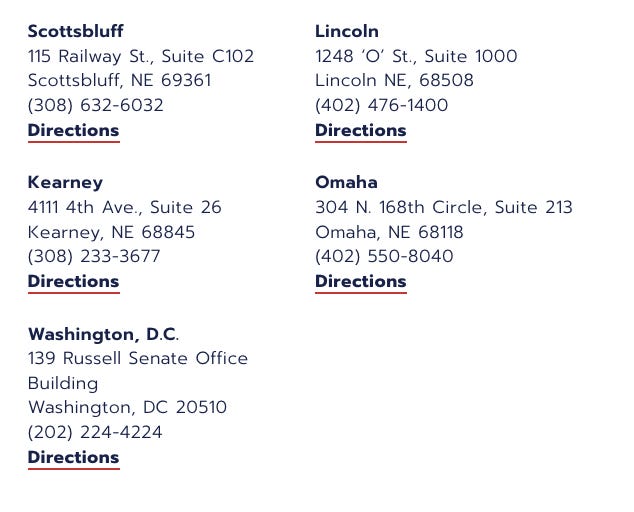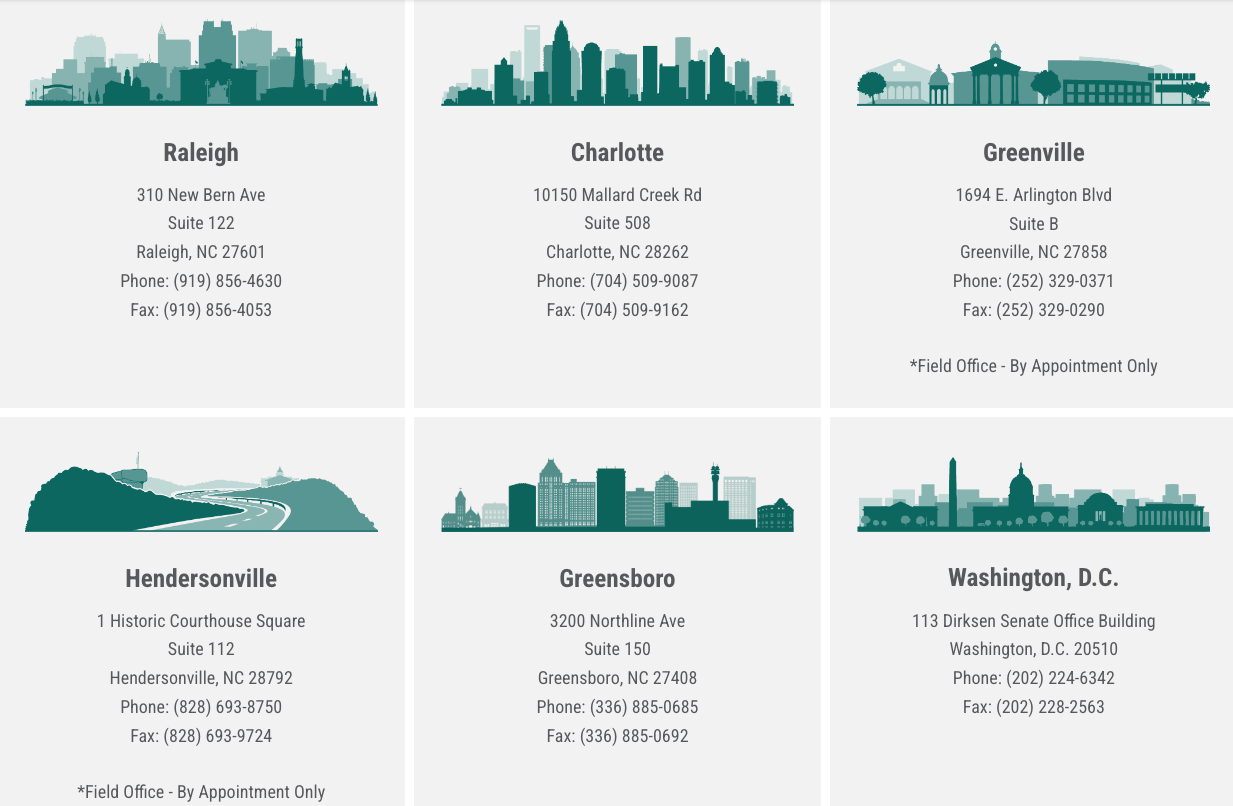Updated: 1:42 a.m. ET. Fri, Oct. 17.
Editor’s Note: We’ll be updating this post daily for the length of the shutdown fight with updates, ideas, insights, and—most importantly—what we can do. This could go on for a few more days, a few weeks, 35 days (Trump’s previous shutdown), or more. We’ll send the usual occasional emails/push via the normal DisRev Newsletter, but if you want more frequent shutdown-related updates: Sign Up Here.
Day 16: What will be left to reopen?
After a certain point, we’ll have to ask ourselves if what reopens is anything more than a technicality — a facade. Will it be the American government we’ve known since the 1940s or just a hollowed-out shell of itself? A police state with ribbons.
More than 4,200 federal employees have been laid off, with Trump threatening thousands more.
More than 750,000 federal employees are furloughed (without pay), and Trump is threatening all sorts of pain — from never bringing some back to not giving back pay to those who do return.
To be clear, both of these moves — the layoffs and the threats of nonpayment — are illegal. And on Wednesday a judge said as much and blocked the attempted layoffs, protecting the 4,200 workers.
The courts have stepped up to check the power of the executive branch. Now Congress must do so as well.
Soon, Democrats will need to add to their list of demands a full reopen — meaning a full reinstatement of anyone laid off during the shutdown and a full reimbursement of backpay as the law explicitly states — a law Trump signed.
Day 15: Bernie & AOC Town Hall
Day 14: They are already talking about Thanksgiving
In a sign of where things are at, Republicans were already trying to blame Democrats for travel woes… over Thanksgiving. That’s — check’s notes — over a month away.
Not great.
On Tuesday, the Senate failed to pass the GOP spending bill for an 8th time. They also didn’t allow Democrats to hold votes on their spending bill.
Meanwhile, military members will get paid on Wednesday. The Pentagon is moving money around to make payroll this cycle. That eases pressure on Congress… for now.
The next payday for federal workers is Oct. 24th. That will be the first time many of the 750,000 furloughed employees won’t receive any paycheck at all. Most of them received a partial paycheck on Oct. 10th. Another military payday comes shortly thereafter on the 29th.
However, the big deadline now is Nov. 1.
That’s when Obamacare open enrollment starts for 2026, and people will be seeing their new eye-popping premiums as they select healthcare plans.
“The closer to Nov. 1, a lot of these elected officials are going to start hearing from their constituents,” Sen. Ruben Gallego told Politico.
Day 13: Our John McCain Moment
The shutdown fight is about Obamacare. The past 15 years of Republican politics have been about Obamacare. For Tea Party Republicans, it’s been a crusade-like journey to roll back Pres. Obama’s crowning achievement. For Trump, it’s been a vendetta to erase Obama wholesale.
Dress it up different all you want — add more context, less restraint, bigger stakes. This is just a bad reboot. (Not that we much enjoyed the first one.)
This is a sequel to a sequel to a sequel to a remake.
Last time, central casting sent us former Speaker Paul Ryan and his Wisconsin biceps.
PUMP IRON, CUT Medicaid! #GAINS
This time, they sent Speaker Mike Johnson and his gentlemanly Louisiana drawl.
“I do declare, we’ll take your healthcare.”
As much as things change, they stay the same.
In the last episode (of this, our endless groundhogs day), a big chink in Trump’s armor was exposed when Republican Sen. John McCain walked dramatically onto the Senate floor during an attempt to repeal Obamacare in 2017. He strode up to the lectern, paused, and gave a big thumbs down — killing the effort and saving the ACA. The made-for-TV moment was a blow to the reality TV president.
Here we are again: Defending healthcare for millions of Americans as both a tangible reality and as a symbol against authoritarianism.
This is our Trump II John McCain Moment. We must do it again.
Day 12: Key Republicans to Pressure UPDATED
Sen. Pete Ricketts of Nebraska
Ricketts is up for reelection in 2026 against independent populist Dan Osborn, who has a good shot of taking the seat in a deeply red state. Rural healthcare is the most under threat due to Republican cuts to Medicaid and Obamacare premiums rising. Midwest states like Nebraska will feel this. Clinics and hospitals will likely contract or close.
This is on top of the pain the agriculture economy is experiencing in the state between the ICE raids and tariffs. Ricketts is vulnerable, and voters should make him feel it.
Two ways to do that:
Let him hear it:
Call, write, and show up at his offices. The Oct. 18th No Kings protest should include each field office in Nebraska.
Let him see it:
Support challenger Dan Osborn in any way you can. Make him go viral online, make signs, donate. Nothing would scare the GOP more than seeing a Red State senator underwater.
Winning the Blue Dot: GOP Rep. Don Bacon of Omaha (NE-2)
Staying in Nebraska, Biden won Rep. Don Bacon’s district in 2020. Kamala won it again in 2024. But Republican Don Bacon has kept it by running (slightly) away from Trump when necessary — particularly in 2020. It’s a must-win for Democrats in 2026 and a flippable district.
Again, Nebraska is in the crosshairs of Trumps healthcare cuts, ICE crackdowns, and tariffs. Meanwhile, Omaha has a robust healthcare sector where Medicaid and Obamacare cuts could affect the economy. Additionally, South Omaha is known as the Spanish part of town with a vibrant Latino community.
His district office: Omaha Office 13906 Gold Circle, Suite 101. Omaha, NE 68144 Phone: (402) 938-0300. Fax: (402) 763-4947
Rep. Jeff Hurd of Colorado’s 3rd District
Hurd is headed into a tough reelection fight. He serves a district with swaths of rural and frontier land where Medicaid and Obamacare are crucial. Cuts will hurt his constituents. Nearly a third (31%) of his district is covered by Medicaid, the most of any congressional seat in that state. $1.7 billion worth of Medicaid money went into CO-3 last year, a huge economic impact.
While he’s yet to show the courage to buck MAGA, he has expressed more moderate leanings than many of his counterparts.
Sen. Thom Tillis of North Carolina
Tillis is one of the few Republicans left willing to buck MAGA and Trump. That’s why he’s not running for reelection in 2026. He’s not beholden to the political pressure of his GOP counterparts.
Health analysts predict Obamacare premiums will jump nearly 30% on average (almost 10% higher than the national average) in North Carolina if the ACA tax credits expire. For some people it will be drastically higher.
Additionally, the seat is flippable and key for Democrats in 2026. Any sort of movement or action now in that state will help next year in the Midterms.
Sen. Susan Collins of Maine
Collins is up for reelection in 2026 and currently underwater in the polls. The seat is Democrats’ most important pickup opportunity in the Midterms. She’s vulnerable and should feel as vulnerable as the constituents she’s leaving out to dry.
Health insurance is set to “skyrocket” in Maine, according to local media. The state could see the highest increase in premiums in the Northeast region. Depending on if you have insurance individually, for a family, or through your work, you could see premiums jump 19% to 32% in Maine.
The jump in cost is due to a few things:
Pharmacy costs are increasing due to tariffs, according to officials.
34,000 people will get kicked off Medicaid.
Hospitals and clinics in the state are worried they won’t be able to cover costs.
Cuts to Obamacare that are currently saving Mainers $50 million this year.
Sen. Collins needs to see that saving healthcare for Americans will also save Maine.
Two ways to help:
Let her hear it:
Call, write, and show up at her offices. The Oct. 18th No Kings protest should include each field office in Maine.
Let her see it:
Support her challengers in any way you can. Make them go viral online, make signs, donate.
I have a current favorite: Graham Platner. He is anti-establishment, anti-oligarchy, and has a message of both strength and empathy that needs to get into the bones of this party.
Sen. Lisa Murkowski of Alaska
The Essential Air Services program, which ran out of money on Sunday, is hugely important for Alaska — both a frontier state and the largest state in the union. The state received $41 million from the program. Some of these communities don’t have roads; air is the only way in or out for medicine and basic supplies.
Meanwhile, Alaska already has the highest healthcare costs in the nation.
Medicaid covers 38% of Alaskans. 1 in 3 births in Alaska were covered by Medicaid.
Health insurance premiums could jump as high as 700% for some people.
Source: Alaska Public Media
Murkoski Alaska offices
Day 11
Republicans are losing the shutdown fight. This is important not only for defending healthcare for millions of people, not only for making sure hundreds of thousands of federal workers and military members receive their paychecks, but also for breaking Trump’s mirage.
So much of the Trump Administration’s strategy is based on the illusion of inevitability. They want people to think—to feel—as though nothing can stop their march toward authoritarianism. This requires the perception of power they don’t have and a sense of momentum. It requires people and institutions obeying in advance — giving the fascists permission before they’ve even demanded it. It requires a conceit of total compliance.
Now that conceit is cracking.
Democrats in Congress have found their backbone for the first time in nine months. And just this simple, single act of defiance has rattled Republicans.
A majority of Trump supporters want to extend Obamacare tax credits.
Trump districts and states will be the most affected by Republican cuts to Medicaid and Obamacare, and people are starting to figure that out.
Polls show voters are blaming Trump and Republicans for the shutdown, while some polls had it closer to a tie — a bad omen for the incumbent party.
The rubber meets the road this week.
On Sunday, the Essential Air Services ran out of money. The EAS serves 177 rural airports by subsidizing their services. That helps connect those communities to larger cities and airports. This is important for the economy of those rural areas and — again — for healthcare. Those airports connect them to critical medical services.
On Tuesday, the Senate returns to DC.
On Wednesday, military members are scheduled to miss their first paycheck. Trump is pushing Hegseth to avoid that, though it’s unclear if the call is performative or will actually happen.
Most federal workers will receive one more paycheck from their last pay cycle ending on Sept 30th. Meaning they’ll get paid less than they’re owed since three days will be missing from their paystubs. Those workers will not receive a paycheck after that.
This moment is a huge opportunity in the battle to resist authoritarianism. With so many people’s livelihoods at stake, with Trump ignoring courts to use the military against U.S. citizens, the stakes have never been higher. Read more on how to help.
“They are weaker than they look. And it is important that we remember that because what they rely on is the impression of power… They rely on that perception of inevitability and power so that people comply in advance and acquiesce in advance and give up in advance.” — Rep. Alexandria Ocasio-Cortez
Day 10: Republicans didn’t do the homework.
The past 48 hours have revealed that Republicans saw the shutdown as just another political game where they could use brute force to win the messaging battle and continue down their ideological rampage with little care for how it would affect regular people — particularly their own voters.
But numbers don’t lie. Reality is setting in.
The numbers vary, but somewhere between 15-17 million people will lose their health insurance due to GOP attacks on Medicaid. Another 20 or so million people will see premiums jump 100+% if Obamacare tax credits aren’t extended. And let’s be clear: if your monthly health insurance bill doubles — triples, quadruples — in cost per month and you can’t afford it, you don’t have health insurance. If you have to take a deductible that’s so high you’re risking bankruptcy, you don’t have health insurance.
The kicker is this will affect red states and MAGA voters far more, leaving large swaths of the country underinsured, uninsured, and without clinics or hospitals.
Everyone from healthcare CEOs to hospital workers warned about this. Democrats warned about this. Healthcare advocates warned about this. Republicans just thought it was a game. Your healthcare is a game to them.
Now they are realizing all that data, all those warnings, all those people, are real. Some of them have the audacity to stand up to their party, like Rep. Marjory Taylor Greene. But others continue to think they can lie their way out of causing Americans so much pain.
Day 9
Big update: The senate has left town and is not scheduled back until Tuesday.
Major dates coming up:
Most federal workers are set to receive one more paycheck from their last pay cycle ending on Sept 30th. Meaning they’ll get back for those two weeks minus a couple of days.
Those workers will not receive the paycheck after that.
Military workers will not receive a pay check on Oct. 15, much sooner.
This was not on my 2025 bingo card: Marjorie Taylor Greene is talking about people struggling to pay for healthcare and concerns over the expiring ACA tax credits.
This as polls show voters are blaming Republicans for the shutdown. The truth is getting through.
Day 8
Healthcare is so basic, it’s such a low bar. And still we are told it’s too much.
“Standing up for 75 million Americans in this moment to defend the rights of people to go into a little less debt seems like the least they could fucking do.” - Jon Stewart on the shutdown.
Day 7
Update: The Senate will not vote to end the shutdown again until Thursday.
As of Monday, more than 620,000 federal workers had been furloughed.
A reminder: Congress still gets paid during a shutdown.
If ACA tax credits aren’t extended, Obamacare premiums will jump nearly 20% across the country—almost 29% in North Carolina.
Without the changes Democrats are asking for: 15 million Americans could lose their healthcare at the end of the year. As many as 20 million people could see their premiums double.
A personal note:
I have mixed feelings about the shutdown. You probably share some of them.
Shutdowns hurt normal, everyday people. As of Monday, more than 620,000 federal workers had been furloughed thus far. Estimates say they could climb about 100k or more. Those are real people with real mortgages and rents to pay, with kids, with livelihoods and futures on the line.
Generally speaking: Democrats, progressives, and left-leaning voters tend to be against shutdowns because of exactly those things—because we value the dignity of workers and the importance of good governance.
Shutdowns are often political games, messaging battles, brinksmanship, theatre that happen on stage and on TV cameras while normal people have to suffer through it.
Generally speaking, I’m against shuttering our government, just like I’m against gerrymandering. Yet, I find it necessary for California to gerrymander its maps in order to fight against Republican power grabs in Texas and Missouri; I find it necessary to save our democracy.
The budget process is one of the few tools Democrats have while in the minority. Using it feels hopeless (a choice between two poisons); it feels late (this would have been more effective in March); it feels like something the other side would do. And yet, it feels necessary in this moment—necessary to save our republic.
We are in unprecedented times.
Nothing—and I mean nothing—is currently standing in the way of this authoritarian administration’s march to consolidate power. They are moving faster than even the history books suggest a fascist regime would and should.
Standing up, in any way possible, and delivering the first substantive defeat to this White House would be an extraordinary step. It would deliver a body blow and slow Trump’s unchecked power. It would also help the opposition party get up off the floor.
And yet it’s not banks or Fortune 500 companies or billionaires or even politicians having to bear the burden of the fight for freedom and democracy; it’s workers. It’s always workers. That has to change. —Álio
Day 6:
There will be a seventh day after Monday’s Senate vote failed as expected. Republicans refused to negotiate, and Democrats held their line.
In a sign that things are fraying earlier than usual:
This weekend saw ground stoppages at Newark and Denver airports due to a shortage of air traffic controllers. DEN is the 6th busiest airport in the world (and 3rd in the U.S.); Newark is 41st. Trump’s last shutdown in 2019 ended, in part, because air traffic controllers started calling in sick. According to the NYTimes, Transportation Sect. Duffy said there has already been an uptick in controllers calling in sick.
A guest from Navy Federal Credit Union told Marketplace they are seeing more requests for loans at this point in the shutdown compared to 2018-2019. The bank offers zero-interest loans to federal workers for shutdowns to help them cope with the massive financial burden. Is this because federal workers are preparing early for the long haul after a 35 day shutdown last time? Are federal workers already hurting financially?
Trump opened the door to negotiating with Democrats. I was shocked by this. But he reversed course just a few hours later. Was it Trump being Trump? Or is he already feeling the pressure?
Bernie can help you call your GOP senator
His campaign just sent out this message to help mobilize phone calls to Republican senate offices.
You fill out a quick form and it connects you really fast. Here’s the script:
Hi, my name is [your name], and I’m calling to urge you to stop refusing to negotiate with Democrats and to reopen the government.
The current proposal that YOU support would double premiums for 20 million Americans, take away healthcare from 15 million, and do nothing to stop Trump’s authoritarian takeover of the US government.
As your constituent, I’m urging you to vote for a bill to protect our healthcare, stop authoritarianism and fund the government.
Thank you.
Key GOP Members to Pressure
Sen. Susan Collins of Maine is up for reelection in 2026 and is currently underwater in the state. The seat is Democrats’ most important pickup opportunity in the 2026 race. Her independent counterpart, Sen. Angus King, has also voted against a shutdown. This means she’s unlikely to flip if both senators are seeing the same concerns in their constituents. However, her weak position heading into the Midterms means she’s likely more amenable to negotiations, which at this point would be a leap in progress.
Sen. Thom Tillis of North Carolina is one of the few Republicans left willing to buck MAGA and Trump. He’s not running for reelection in 2026 and therefore not beholden to the political pressure of his GOP counterparts. More importantly, health analysts predict Obamacare premiums will jump nearly 30% (almost 10% higher than the national average) in North Carolina if the ACA tax credits expire.
Sen. Pete Ricketts of Nebraska is up for reelection in 2026 against populist Dan Osborn, who has a good shot of taking the seat in a deeply red state. Rural healthcare is the most under threat, with cuts to Medicaid and Obamacare premiums rising. Clinics and hospitals could contract or close. This is on top of the pain the agriculture economy is experiencing in the state between the ICE raids and tariffs. He’s vulnerable, and voters should make him feel it.
The same factors apply to Sen. Joni Ernst of Iowa, who is not running for reelection and might not feel as beholden to Trump’s loyalty tests. An argument for affordability and rural healthcare could make her come to the negotiating table.
Rep. Jeff Hurd of Colorado’s 3rd District is headed into a tough reelection fight. He serves a very rural and frontier district where Medicaid and Obamacare cuts will likely hurt most of his constituents. While he’s yet to show the courage to buck MAGA, he is more moderate than many of his counterparts.
Rep. Don Bacon of Omaha (NE-2) has faced multiple close elections to keep his seat, including when Biden and Kamala won the district in 2020 and 2024, respectively. It’s a very flippable seat, and Bacon has kept it by running (slightly) away from Trump when necessary, particularly in 2020. Meanwhile, Omaha has a robust healthcare sector where Medicaid and Obamacare cuts could affect the economy. All of this means he could see the need for negotiations and compromise.
Day 5: What can we do?
It’s so easy in these moments to sit on the sideline and feel powerless. But the reality is this moment needs our activism more than ever.
Flashpoints like this receive more “bang for your buck” than even massive protests, such as the No Kings nationwide demonstrations months ago. Those occur in a vacuum without a specific ask. General protests like No Kings are great for energy, solidarity, and an overall thumbs down to the status quo. However, they don’t have a specific ask, just an overall “fight back” or a long wishlist of various policy items. But that kind of protest now would deliver a more resounding message and a clear deliverable—extend Obamacare tax credits and reopen the government—and therefore a victory.
Fights without specific deliverables are hard to convert into a clear progress. And tangible progress is extremely important. It’s what voters care about most.
So what can we do?
Support these senators:
Democratic senators in swing states, particularly those up for reelection, need to know voters have their back — and the GOP needs to know that too.
Sen. Jon Ossoff, D-GA
Republicans see Georgia as one of their best pickup opportunities in 2026, and Democrats need to hold the seat if they want any hope in winning the Senate now or anytime in the near future.
If numbers came out that Ossoff suddenly saw a boost in support, that would scare not only his opponents but all congressional Republicans. The best way to do this is by helping him go viral and boosting his standing nationally so his donation numbers go up. (Or if you’re in a position to give, donate directly.) And as always, calling and writing letters of support helps elected officials know they aren’t standing in a field alone.
Sen. Jeanne Shaheen, D-NH
New Hampshire is a Blue-ish state. Democrats win consistently, but it’s always a nail-biter. The state also has one of the more popular GOP governors in the country. All that to say, Sen. Shaheen needs to know what Democratic voters want. She sits on the Appropriations Committee and hates shutdowns. She voted for the budget bill back in March, but she’s a huge supporter of Obamacare and doesn’t want the tax credits to expire.
She is not seeking reelection. (She’s held the seat since 2009.) So this is a matter of making sure she hears from you.
Independent candidate Dan Osborn, NE
GOP Sen. Pete Ricketts is running scared in Nebraska. Osborn nearly beat Sen. Debb Fischer in 2024, and he’s back at it again for 2026. Nebraska farmers are hurting due to ICE crackdowns and tariffs affecting everything from who can work to the cost of their farm equipment to where they can sell their harvests. While Osborn obviously does not have a vote in the shutdown fight, a surge in national profile (and donations) would scare Ricketts and GOP house members in swing districts—like Omaha.
Sen. Brian Schatz, D-Hawaii
Schatz doesn’t need anyone’s money or political support. His state is as blue as the ocean around it. However, Schatz is Schumer’s deputy and one of the Democrats who flipped to avoid a filibuster on the GOP budget back in March. He needs to know there can’t be a repeat of March, especially not now.
Be visible, protest, & demonstrate:
Protest everywhere and all over your communities. These can come in various strategies and sizes.
Head to visible locations like major intersections and protest loudly and clearly from the sidewalk. This way you are telling supporters, “Hey, you’re not alone.” This is a way of telling people on the fence, “Hey, we aren’t trying to get in your way as you drive to work, but just know we are fighting for you too.” And you’re telling people against you, “We are here, and we are not afraid.”
Other locations can include major pedestrian areas, bridges over major freeways, and highly visible locations where you can project strength without causing more pain to the people you’re trying to win over.
Protest at Republican congressional offices, both in the Senate and House. Here, you want to be loud and disruptive. You want members of Congress to feel it, even if they aren’t there. The message needs to get back. Let local media and national politically focused media know that you’ll be there.
Day 4: History
In 1995-1996, two back-to-back shutdowns occurred when Pres. Clinton vetoed two budget bills from GOP Speaker Newt Gingrich. Put simply, Republicans wanted to make major cuts to social services, shift control of Medicaid to the states, increase Medicare premiums, and cut taxes for the wealthy. Sound familiar? The second shutdown lasted 21 days — a then record — and cost $400 million. The public blamed Republicans and Gingrich for the shutdown, and Clinton would go on to win reelection.
This is a lesson for Democrats today.
“If you say ‘Who get’s fired?,’ it always has to be the top. Problems start from the top.” — Pres. Trump on the 2013 shutdown.
Democrats won the last government shutdown against Trump in 2018-2019. That fight lasted 35 days, making it the longest shutdown in U.S. history. It revolved around funding for a border wall. Rep. Nancy Pelosi said no.
The political dynamic of that shutdown was significantly different. The government closed on Dec. 22, 2018. Democrats had just won back that House in the Midterms a month before, and Pelosi regained the speaker gavel midway through the shutdown.
Additionally, the message and fight were clear: border wall money. Americans did not see Trump’s pet project as a worthy reason to shut down the federal government.
Republicans capitulated on Jan. 25, 2019. The shutdown cost $5 billion, and 380,000 people were furloughed.
If Democrats want a repeat victory, they 1) need to have Pelosi’s tenacity and 2) need to make clear to voters what this is about: healthcare.
A Democratic win = healthcare stays cheaper for Americans.
A Democratic loss = healthcare costs go up for Americans.
Can Democrats win that messaging battle?
Day 3: An attack on Blue States & RIP the Hatch Act
On Wednesday, the administration closed Colorado’s regional hub for the patent office, laying off 30 people and forcing another 300 to move back to DC. There’s not much money to be saved on this; it’s just vindictive. They left the hub in Texas open.
But let’s be clear: This was already planned and had nothing to do with the shutdown—just like nearly all the cuts we’ll see in the coming days.
“This is an effort to intimidate the whole of society.” — Sen. Adam Schiff
On Thursday, Trump cut $8 billion in clean energy funds for Blue states. Money for two infrastructure projects in New York City was cut. ICE and military operations are becoming more violent and aggressive in Portland and Chicago.
They were going to do all this anyway. The shutdown is a pretext, window dressing.
Meanwhile, Trump is weaponizing federal agencies and breaking federal law
Multiple agencies posted pop-ups and banner messages blaming “The Radical Left” and Democrats for the government shutdown. Some federal workers were also forced to place similar messages on their out-of-office email.
This is a clear violation of the Hatch Act, an ethics law that does not allow federal workers and agencies to use tax money for political purposes. It’s why members of Congress cannot fundraise (or dial for dollars) from their offices in the Capitol—they have to walk across the street.
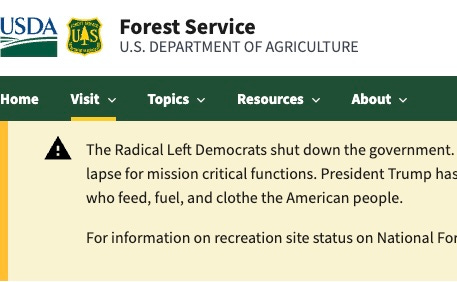
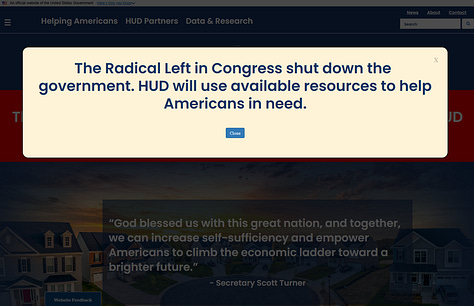
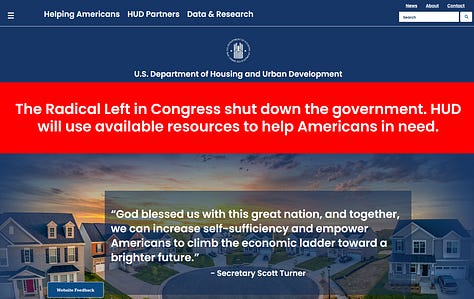
However, Congress is not stepping up, the Dept. of Justice is acting as Trump’s personal law firm, and the Supreme Court seems apt to grant Trump all the deference of an authoritarian.
The founders created a balance of power system based on the idea that personal ambition checks personal ambition. They leveraged human nature and psychology to keep authoritarian power grabs in check. This system does not work with the cult of a strongman.
Day 2: Let’s set the table
Questions I always ask in these chaotic moments:
Who stands to gain here—financially or politically?
What is their motivation?
What does “winning” look like to them?
From the perspective of Pres. Trump, the government can stay closed or reopen; It doesn’t much matter to his administration. The White House will use federal money however they please—“open” government or not. They’ll make their layoffs and cuts, rescind and impound funds, shovel more money towards ICE, and continue their unrestrained march toward a unitary president.
Trump will reopen the federal government if he sees a TV ratings advantage in doing so, but that’s about it. If left to his own devices, he’ll never reopen. He sees the shutdown as an extraordinary opportunity to consolidate power towards the system of government he truly wants—a monarchy.
Congress is the only group with an interest in reopening, and it will all come down to which side capitulates first.
Democrats in Congress needed to take a stand (finally), and they used one of the few weapons available to the party out of power. They leveraged the budget rules to negotiate on one of the only issues where voters still trust them: protecting healthcare.
If Democrats blink, Republicans will celebrate the win, and the Trump cuts will continue anyways. A Democratic collapse will leave people, particularly federal workers and Democratic voters, wondering three things:
What was this all for?
Here they go losing again…
Are these people up for the task? Are they worth anything?
If Republicans negotiate, Democrats will have kept Medicaid and Obamacare alive—saving some families as much as $1400 a month in healthcare costs. That win would be on par with the late Sen. John McCain’s infamous thumbs-down vote, when he joined Democrats in rejecting a Trump attempt to repeal Obamacare in 2017.
And Democrats need a win—both for their own party and for voters who view them as feckless in the face of fascism.
AOC, Bernie, and their friends in Congress need activists and voters now more than ever. They need you.
Day 1: Is this the last government shutdown?
There’s a chance that we just witnessed the shutting down of the federal government for the last time. This is not a certainty, perhaps not even likely.
But for the first time in modern history, it’s a distinct possibility.
There was a strangeness in the procedural nature—normality—of the shutdown. Yes, we have the endless headlines, the typical finger-pointing and brinksmanship and high-stakes rhetoric—all part and parcel of a funding showdown. But, in the long scheme of things, it was routine.
I can’t help but think: Are we quietly acting as if this is business as usual when we’ve just witnessed the end of the U.S. republic? Is this how liberty dies? Not with thunderous applause, but with the banality of parliamentary procedure? — Alio




